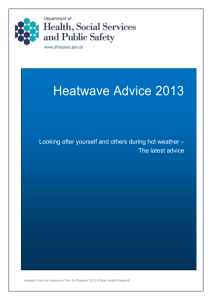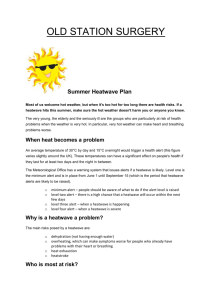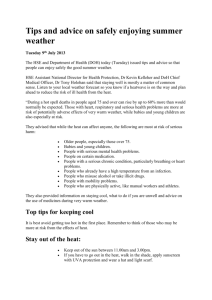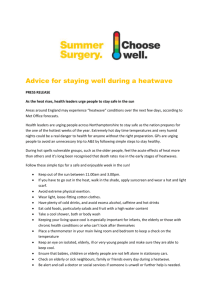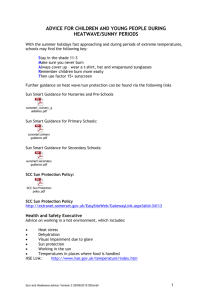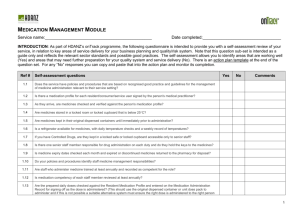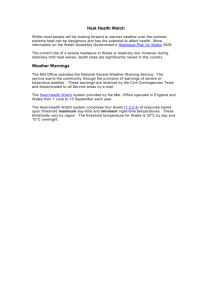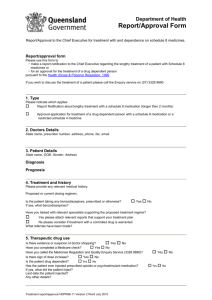Important Reminder about Caring for Older People in Warmer Weather
advertisement
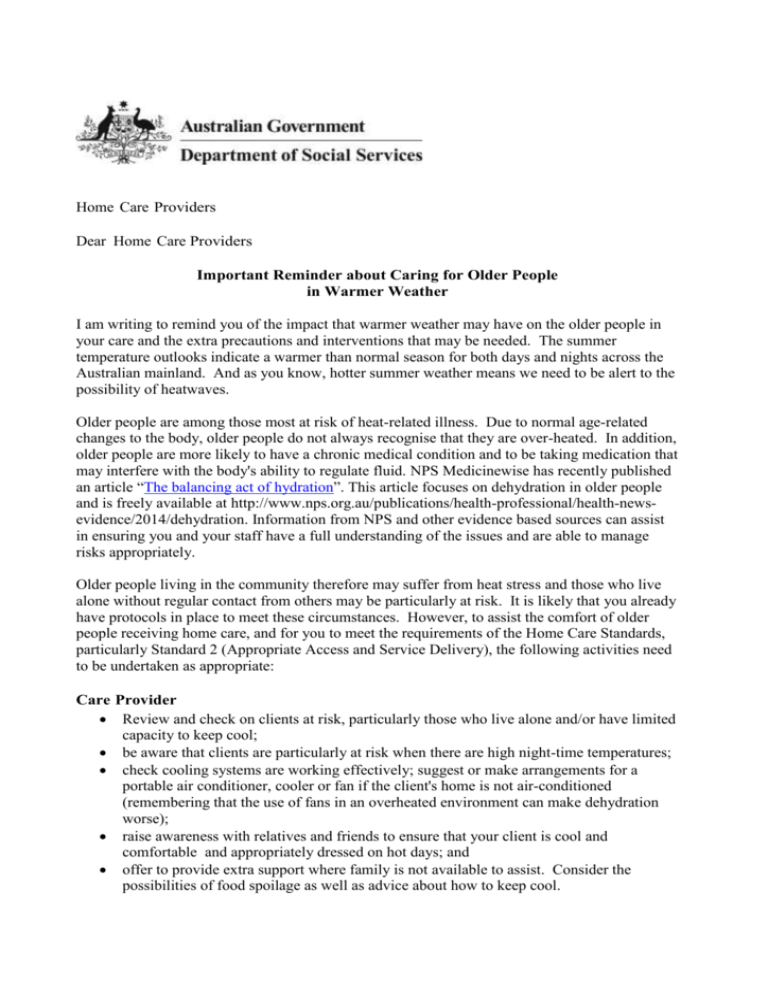
Home Care Providers Dear Home Care Providers Important Reminder about Caring for Older People in Warmer Weather I am writing to remind you of the impact that warmer weather may have on the older people in your care and the extra precautions and interventions that may be needed. The summer temperature outlooks indicate a warmer than normal season for both days and nights across the Australian mainland. And as you know, hotter summer weather means we need to be alert to the possibility of heatwaves. Older people are among those most at risk of heat-related illness. Due to normal age-related changes to the body, older people do not always recognise that they are over-heated. In addition, older people are more likely to have a chronic medical condition and to be taking medication that may interfere with the body's ability to regulate fluid. NPS Medicinewise has recently published an article “The balancing act of hydration”. This article focuses on dehydration in older people and is freely available at http://www.nps.org.au/publications/health-professional/health-newsevidence/2014/dehydration. Information from NPS and other evidence based sources can assist in ensuring you and your staff have a full understanding of the issues and are able to manage risks appropriately. Older people living in the community therefore may suffer from heat stress and those who live alone without regular contact from others may be particularly at risk. It is likely that you already have protocols in place to meet these circumstances. However, to assist the comfort of older people receiving home care, and for you to meet the requirements of the Home Care Standards, particularly Standard 2 (Appropriate Access and Service Delivery), the following activities need to be undertaken as appropriate: Care Provider Review and check on clients at risk, particularly those who live alone and/or have limited capacity to keep cool; be aware that clients are particularly at risk when there are high night-time temperatures; check cooling systems are working effectively; suggest or make arrangements for a portable air conditioner, cooler or fan if the client's home is not air-conditioned (remembering that the use of fans in an overheated environment can make dehydration worse); raise awareness with relatives and friends to ensure that your client is cool and comfortable and appropriately dressed on hot days; and offer to provide extra support where family is not available to assist. Consider the possibilities of food spoilage as well as advice about how to keep cool. Care Staff Check that the temperature in a client's home is kept comfortable, keeping curtains and blinds closed to reduce excess heat; ensure small amounts of fluids are readily available, rather than large amounts of fluids less frequently; suggest alternative forms of fluid, such as jelly, ice-cream or fruit juice blocks and discourage alcoholic or caffeinated beverages; encourage your clients to eat frequent small meals; encourage clients to wear loose fitting clothing, use sunscreen and keep skin covered when exposed to direct sunlight; encourage clients to seek some shade when outside, and to avoid going outside between 11am and 3pm; offer additional tepid showers or sponging; and observe for signs of heat stress, such as nausea, and changes in appearance including red, pale or severely dry skin. A clinical assessment will be required if your client shows any signs of deterioration. The effects of heat-related illnesses can range from mild conditions such as a rash or cramps to very serious conditions such as severe confusion or heat stroke. Heat may also worsen the condition of someone who already has a medical condition such as heart disease. A special note about medicines Some medicines increase the risk of heat-associated illness in susceptible people. These include: medicines that cause dehydration or electrolyte imbalance; medicines likely to reduce renal function; and medicines that interfere with the production or regulation of heat. If your client shows signs of heat-associated illness, report these symptoms to the Care Provider to arrange a review of medication with a pharmacist or general practitioner. A medication review should assess the risks and benefits of any changes to a medication regimen. If you are concerned about a client's wellbeing, his or her medical practitioner should be immediately contacted. You may find it useful to display the attached checklist as a reminder for your staff over the coming summer months. Further information is available from state and territory health department websites. Authorised for electronic submission Susan Hunt, RN, PhD, FRCNA Senior Nurse Advisor Aged Care Quality and Compliance Group 11 December 2014 Attachment: Heatwave Check List - Home Care Heatwave Checklist Before a heatwave occurs Assess which clients are at risk - who has limited capacity to keep cool; or which homes are prone to being hot; check cooling systems in clients homes are adequate and working effectively; ask relatives and friends to ensure clients are cool and comfortable and appropriately dressed on hot days; offer extra support to clients where family and friends are not available to assist; and provide contact details of your clients to the local emergency services, where appropriate. During a heatwave Continue to deliver care - source additional staff or volunteers if required; be aware clients may be at particular risk following high overnight temperatures; keep curtains and blinds closed in clients homes to reduce excess heat; make small amounts of fluids readily available to clients; provide alternative forms of fluid, and discourage alcoholic or caffeinated beverages; encourage clients to eat frequent small meals; encourage clients to wear loose fitting clothing, use sunscreen and keep skin covered when exposed to direct sunlight; encourage clients to seek shade when outside, and to avoid going out between l1am and 3pm; offer additional tepid showers or sponging; observe for signs of heat stress, such as nausea, and changes in appearance including red, pale or severely dry skin; and request a clinical assessment if your client shows any signs of deterioration.

